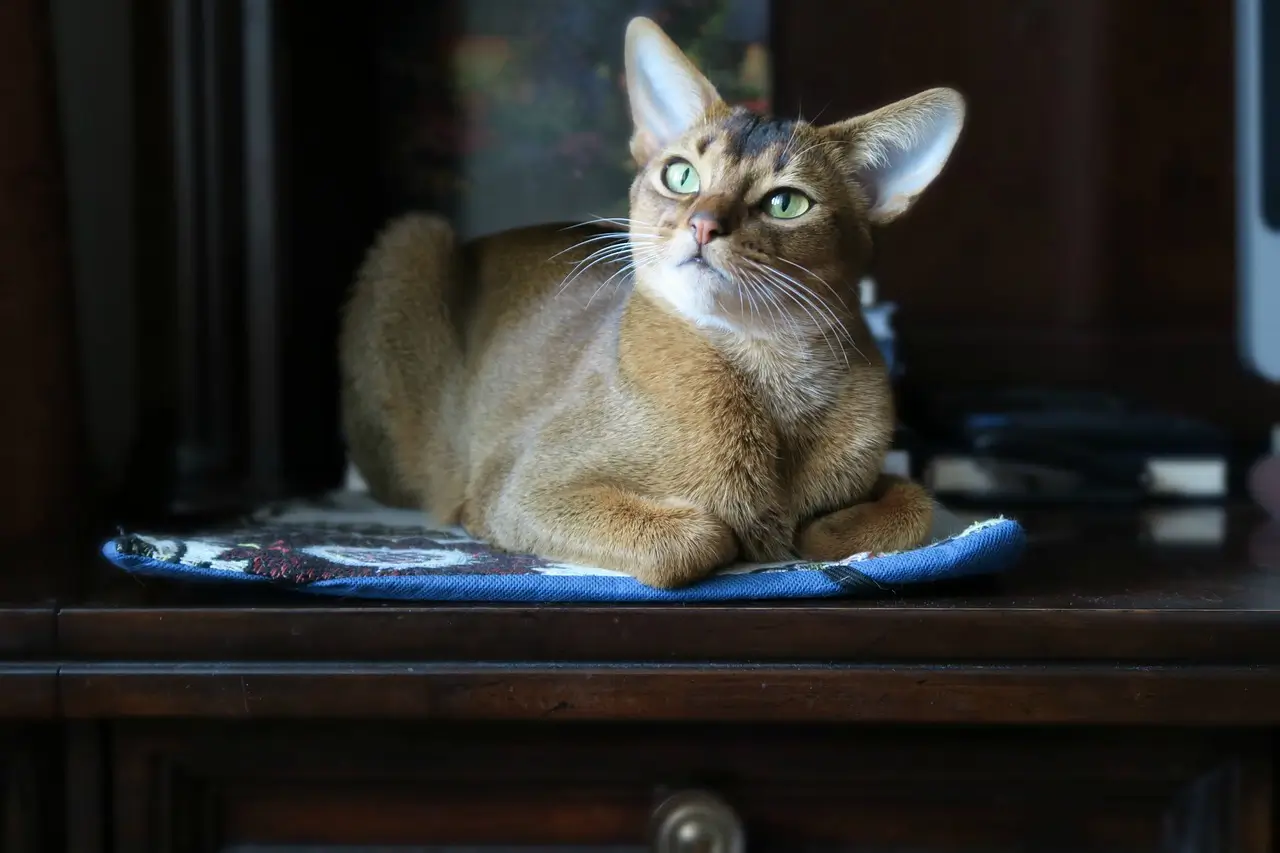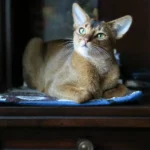Abyssinian cats are among the oldest and most beloved domestic cat breeds, renowned for their striking beauty, playful personalities, and intelligent nature. With a history that dates back thousands of years, these cats are often associated with ancient Egypt, where they were admired for their elegance and grace. Today, Abyssinians remain one of the most popular and sought-after breeds, thanks in part to their stunning coat and engaging demeanor.
What truly sets Abyssinians apart from other breeds is their distinctive coat. Known for its unique ticking pattern, where each hair is banded with multiple colors, Abyssinian cats display an array of gorgeous shades that range from warm reddish tones to cool bluish hues. These coat colors, combined with their lively personalities, make Abyssinians one of the most visually striking and cherished breeds in the feline world.
In this post, we’ll dive into the fascinating world of Abyssinian cat colors. We’ll explore the different color variations—from the classic ruddy and sorrel to the more rare blue and fawn. You’ll also learn about the genetics behind these beautiful coats, the role of breeding in determining color, and how these gorgeous tones contribute to the overall charm of this remarkable breed. By the end, you’ll have a deeper understanding of what makes Abyssinian cats’ coats so exceptional and why their colors continue to captivate cat lovers around the world.
Table of Contents
Understanding Abyssinian Cat Colors: The Main Variations
The Abyssinian cat is known for its stunning, multi-toned coat, which comes in several unique colors. Each of these colors contributes to the breed’s overall elegance and charm, making Abyssinians one of the most visually captivating cat breeds. In this section, we’ll take a closer look at the three main color variations of the Abyssinian: ruddy, sorrel, and blue.
1. Ruddy Abyssinian: The Classic Look
The ruddy Abyssinian is the most iconic and commonly recognized color variation of the breed. Its coat is characterized by a rich, warm tone with a reddish-brown hue. The color is the result of a striking ticking pattern, where each individual hair is banded with a dark brown base, a lighter reddish middle, and a dark tip. This multi-tonal effect gives the coat a glowing, shimmering appearance that is especially striking in sunlight.
The ruddy coat is considered the “classic” Abyssinian color, and it is highly prized by breeders and enthusiasts. This variation is also the breed standard in most cat registries, including the CFA (Cat Fanciers’ Association) and TICA (The International Cat Association). As a result, many Abyssinians displayed in cat shows typically feature the ruddy coloration, and it’s the most sought-after color among those adopting the breed.
Historically, the ruddy variation is believed to be the original coat color of Abyssinians, with some experts speculating that it was favored in ancient Egypt, where the breed is thought to have originated. This rich history has contributed to the deep appreciation for the ruddy coat, making it the most popular choice among cat lovers.
2. Sorrel Abyssinian: The Red-Toned Beauty
The sorrel Abyssinian stands out due to its stunning reddish hue. Unlike the warm brown tones of the ruddy Abyssinian, sorrel cats have a rich coppery-red coat with a similar ticking pattern. Their coat exhibits a striking contrast, with lighter shades of red at the base and deeper reddish-brown tips on each hair, giving them a warm, fiery glow.
One of the key differences between the sorrel and ruddy variations lies in the undertones. While the ruddy coat has a more brownish base, the sorrel has a distinctly reddish base that can appear almost cinnamon-colored in some lighting. This gives the sorrel Abyssinian a more vibrant, reddish appearance, making it highly popular among those who are drawn to bold, eye-catching colors.
The sorrel coat color is genetically influenced by a recessive gene, which means that for an Abyssinian to have a sorrel coat, both parents must carry this gene. While not as common as the ruddy variation, the sorrel color is increasingly seen in breeding programs focused on introducing more variety to the Abyssinian’s color palette.
3. Blue Abyssinian: The Unique Soft Tint
The blue Abyssinian is one of the rarer and more unique color variations of the breed. This coat features a soft, silvery-blue tone, with each hair being a pale gray-blue, darker at the tips and lighter at the base. The result is a subtle, cool-toned look that stands out in a more understated way compared to the warmer ruddy and sorrel colors.
Genetically, the blue color is the result of a dilution of the ruddy gene. The “blue” color is created when the genetic mutation causes the reddish-brown tones of the ruddy Abyssinian to be lightened to a cool grayish-blue. The blue Abyssinian is not as common as the ruddy or sorrel varieties, and breeding for this color can be challenging due to its recessive genetic traits. As a result, blue Abyssinians are often considered rare and can be more expensive than their more common counterparts.
Despite its rarity, the blue Abyssinian is gaining in popularity among cat enthusiasts who appreciate its soft, silvery hue. The distinct blue coat adds a sophisticated elegance to the breed, making it a highly sought-after color among collectors and breeders alike.
Other Fascinating Abyssinian Coat Colors and Patterns
While the ruddy, sorrel, and blue variations are the most commonly recognized colors in Abyssinians, this breed offers a few more unique shades and fascinating patterns that add to its allure. In addition to these primary colors, Abyssinians can have subtle shades like fawn, and their characteristic coat patterns further contribute to their distinctive look. In this section, we will explore the fawn color, the striking ticking pattern, and some of the rare colors that are occasionally seen in Abyssinians.
1. Fawn Abyssinian: A Subtle and Elegant Shade
The fawn Abyssinian is one of the more subtle and refined color variations in the breed. This color is often described as a pale, warm beige or light gray with a soft, creamy undertone. The ticking in the fawn Abyssinian is light and delicate, with the hairs gradually darkening towards the tips, giving the coat a gentle, almost ethereal glow. The fawn shade is less intense than the ruddy or sorrel variations but still exudes an elegance that is characteristic of the breed.
The primary difference between the fawn Abyssinian and other color variations lies in its softness and subtlety. While ruddy Abyssinians display a richer, more vibrant tone, the fawn is more muted and light in comparison. The blue Abyssinian, while also a pale color, has a cooler, silvery tint, whereas fawn Abyssinians have a warmer, golden undertone. This makes the fawn variation a beautiful choice for those who prefer a more understated, yet still striking, cat.
Caring for an Abyssinian with a fawn coat is much like caring for any other Abyssinian, but owners should be aware that their coat can sometimes show dirt or oils more easily due to the lighter color. Regular grooming, including brushing to remove loose hairs and prevent matting, will help maintain the coat’s softness and sheen. Bathing should be done as needed, but it’s important to use gentle, pet-friendly products to avoid stripping the coat of its natural oils.
2. Abyssinian Coat Patterns: Beyond the Colors
One of the most distinctive features of the Abyssinian is its unique coat pattern known as “ticking.” Ticking refers to the way each hair is banded with multiple colors, creating a subtle gradient effect that gives the coat a shimmering, glowing quality. This pattern is one of the defining characteristics of the breed and is found in every color variation, from the ruddy to the blue to the fawn.
The ticking pattern consists of several bands of color on each hair. The base of the hair is lighter, the middle is darker, and the tip is the darkest. This gives the coat a beautiful depth and dimension that is especially noticeable when the cat is moving or in the sunlight. The ticking pattern also adds a level of complexity to each color, making each Abyssinian’s coat appear to change depending on the light and angle.
Unlike the more solid coat patterns seen in some other breeds, Abyssinians do not have distinct spots, stripes, or blotches. Their coat is characterized by the fine, uniform ticking that provides a radiant glow without the bold patterns of a tabby cat. This gives them a refined, almost mystical look that makes them stand out in any crowd. Understanding the ticking pattern is key to fully appreciating the beauty of the Abyssinian’s coat.
3. Rare and Uncommon Abyssinian Colors
While the main Abyssinian coat colors are ruddy, sorrel, blue, and fawn, there are also rarer and less commonly seen variations that add even more intrigue to the breed. One of the rarest of these colors is the silver Abyssinian, which has a similar ticking pattern but with a much lighter, silvery base color. Silver Abyssinians can be strikingly beautiful, with the lightness of their coat enhancing the shimmering quality of their ticking pattern. These cats have a refined, ethereal appearance, and their rarity makes them highly sought after by collectors and breeders.
Other rare colors that occasionally appear in Abyssinians include chocolate, lilac, and cinnamon, though these are not yet officially recognized by all breed registries. These colors are the result of specific genetic mutations and can be quite difficult to breed for due to the complex nature of feline genetics.
Genetics plays a crucial role in determining the coat colors of Abyssinians. The inheritance of color genes is based on a combination of dominant and recessive traits, and the presence of specific mutations can lead to the production of these less common colors. As a result, breeders must be very knowledgeable about genetics and carefully plan their breeding programs to produce these rare and beautiful color variations.
The role of breeding in producing these unique colors is significant. Breeders often select specific pairings to enhance certain traits, including color and pattern, to ensure that the resulting kittens meet the desired standards. This careful selection process can sometimes result in the appearance of rare colors, although it can take time to achieve consistent results
How Abyssinian Cat Colors are Determined: The Role of Genetics
The striking coat colors of the Abyssinian cat are not just a matter of appearance; they are the result of complex genetic factors that determine how each color variation comes to life. From the classic ruddy to the rare blue and fawn shades, the colors of Abyssinians are influenced by both dominant and recessive genes, as well as genetic mutations that bring out the unique qualities of this breed. In this section, we’ll explore how genetics plays a critical role in determining the color of an Abyssinian’s coat and how breeders work to maintain and enhance these beautiful hues.
1. Genetics and the Inheritance of Coat Colors
Abyssinian cat colors are inherited through genetic mechanisms that determine the presence and distribution of certain pigments in their fur. The primary factor that influences the coat color is the presence of a gene that dictates the production of eumelanin (a pigment responsible for darker colors) and pheomelanin (responsible for lighter or reddish hues). These pigments interact to create the different color variations, such as the rich reddish-brown of the ruddy Abyssinian or the cooler tones of the blue.
The inheritance of these colors follows basic Mendelian genetics, where some traits are dominant and others are recessive. For instance, the ruddy color, which is the most common and widely recognized, is typically the result of a dominant gene. On the other hand, colors like sorrel and blue are influenced by recessive genes, which means that both parents must carry these recessive alleles for the offspring to express these colors.
In addition to these main colors, genetic mutations can also influence rare coat variations like silver or cinnamon. These mutations often occur when a single gene or a combination of genes changes the typical pigmentation patterns in Abyssinians. Such mutations can lead to the creation of new colors or variations, though they are much less common and can be harder to reproduce consistently.
2. Understanding Color Breeding in Abyssinians
Breeding Abyssinians for specific coat colors requires a deep understanding of genetics. Breeders often select cats with particular genetic traits to pair them together in order to emphasize certain coat colors or patterns. This careful selection process is known as “color breeding.”
When breeding for color, the goal is to pair individuals whose genetic makeup supports the desired color. For example, to breed a sorrel Abyssinian, breeders will typically choose two parents who carry the recessive sorrel gene. The more informed the breeding pair, the more likely the offspring will inherit the desired coat color.
Breed standards, as set by organizations like the CFA (Cat Fanciers’ Association) and TICA (The International Cat Association), play a significant role in color breeding. These standards define which colors are officially recognized for the Abyssinian breed and ensure that the breed’s characteristics remain consistent and true to type. For example, the CFA recognizes the ruddy color as the standard, and breeders must follow these guidelines to maintain the breed’s integrity and appeal in cat shows.
The pedigree of an Abyssinian also plays a key role in determining the potential for producing certain colors. Cats with a strong pedigree may be more likely to produce offspring with specific characteristics, such as coat color or pattern. By carefully selecting breeding pairs with desired pedigrees, breeders can increase the likelihood of producing kittens with particular color variations, ensuring the continuity and popularity of these colors within the breed.
3. Why Color is Important in Abyssinian Cats
Color plays an integral role in the appeal and value of Abyssinian cats. Breed standards often prioritize certain colors as ideal representations of the breed, and cats that conform to these standards tend to have a higher market value. This connection between color and breed standards is particularly important for breeders who aim to produce cats that excel in cat shows or meet the expectations of prospective pet owners.
Beyond the market value, color also influences the popularity of Abyssinians. Some colors, like the rich ruddy or the rare blue, are particularly sought after due to their striking appearance. These colors often attract a broader audience of cat enthusiasts and collectors who are looking for a visually captivating cat. As a result, the demand for these colors can affect breeding practices and influence the overall popularity of the breed.
The appeal of specific colors also extends to how Abyssinians are perceived in different cultures or markets. For example, some people may prefer the classic ruddy look for its historical significance and traditional elegance, while others may be drawn to the rarity of the blue or the subtle beauty of the fawn. Each color has its own unique following, and this helps drive both the desire and the value of Abyssinians with these colors.
Conclusion: The Stunning Diversity of Abyssinian Cat Colors
In this post, we’ve explored the fascinating and beautiful world of Abyssinian cat colors. From the classic, warm ruddy to the fiery sorrel, the cool blue, and the subtle fawn, Abyssinians offer a remarkable range of hues, each with its own unique charm. We’ve also delved into the distinct ticking pattern that defines the Abyssinian’s coat, making each color even more vibrant and captivating. And, of course, we’ve touched on the rare and exceptional colors like silver, showcasing the breed’s potential for even more diversity.
As you consider adding an Abyssinian to your family, remember that their coat color is just one part of the equation. Whether you’re drawn to the rich intensity of the ruddy or the rare elegance of the blue, it’s essential to choose a cat that not only suits your aesthetic preferences but also fits your lifestyle and personality. Abyssinians are known for their playful, active, and social nature, so be sure to consider both their appearance and temperament when choosing the right companion.
Ultimately, the stunning diversity of Abyssinian colors allows for a personal connection to the breed based on your color preferences, but remember that every Abyssinian, regardless of color, shares the same amazing personality traits that make them such beloved pets. So, whether you’re captivated by the shimmering ruddy coat or the serene elegance of the fawn, you’re sure to find an Abyssinian that’s perfect for you—both in color and in spirit.
Frequently Asked Questions (FAQ) about Abyssinian Cat Colors
1. What are the most common Abyssinian cat colors?
The most common Abyssinian cat colors are ruddy, sorrel, blue, and fawn. The ruddy color is the breed standard and is characterized by a warm reddish-brown hue with a distinctive ticking pattern. Sorrel has a reddish, coppery appearance, while blue is a diluted, soft gray-blue. Fawn is a pale, light beige with a subtle, warm undertone.
2. Are there any rare Abyssinian cat colors?
Yes, rare Abyssinian colors do exist. Some of the less common shades include silver, chocolate, and cinnamon. These colors are the result of genetic mutations and are often seen less frequently in the breed. Silver Abyssinians, in particular, are known for their lighter, silvery base color and are highly prized for their rarity.
3. How are Abyssinian cat colors determined?
Abyssinian cat colors are determined by genetics, with both dominant and recessive genes influencing the coat color. The breed’s unique ticking pattern is a defining feature, where each hair is banded with multiple colors. The presence of certain genetic mutations can also lead to rare colors, like silver or cinnamon. Breeders select cats with specific color traits to ensure the desired colors are passed down through generations.






